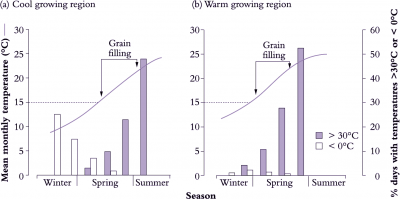Fig14.3.png

Figure 14.3. Wheat-growing areas of Australia have been classified according to the temperature conditions normally prevailing during crop growing seasons (Nix 1975).Temperature increase following heading is common in all regions and plants frequently suffer periods of heat and drought stress during grain filling. Avoiding these late stresses by earlier planting can be difficult, particularly in those regions subject to spring frosts which may damage the developing florets of the inflorescence (ear) (Based on H A Nix (1975) plus other unpublished sources)
Average monthly temperatures are more relevant to plant growth than mean annual values. Timing cardinal stages in plant development (phenology) can often be predicted from temperature measurements taken during the growing season. This integration of time and temperature is expressed in terms of degree-days (see later comments). However, when considering the effect of temperature on yield it is necessary to take extreme conditions into account, particularly at sensitive stages of growth.
Although unseasonally warm growing conditions late in winter are not necessarily harmful to fruit trees, this will often result in early bud break and flower development, increasing the possibility that these more sensitive stages of development will be damaged by a late frost.
For annual crops some degree of adjustment is possible to avoid a particular environmental stress by varying the cultivar or time of planting. However, even this increased flexibility may not be adequate to cope with the irregular nature of many stresses. In the wheat-growing areas of Australia, temperatures increase from the time of heading through to crop maturity so that grain filling often occurs at above-optimum temperatures. Added to this is the possibility of extreme high temperatures (heat shock) or drought. In warmer growing regions these temperature extremes may be avoided in part by earlier planting, but this approach will depend on suitable temperature conditions and the availability of water for germination and seedling establishment early in the year. In cooler wheat-growing regions earlier planting may expose the developing infloresence to possible frost damage resulting in reduced fertility and grain set (Figure 14.3).
